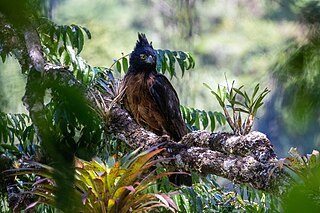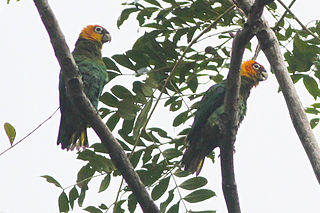
The white-nosed coati, also known as the coatimundi, is a species of coati and a member of the family Procyonidae. Local Spanish names for the species include antoon, gato solo, pizote, and tejón, depending upon the region. It weighs about 4–6 kg (8.8–13.2 lb), and the nose-to-tail length of the species is about 110 cm (3.6 ft) with about half of that being the tail length. However, small females can weigh as little as 3.1 kg (6.8 lb), while large males can weigh as much as 9 kg (20 lb).

The lineated woodpecker is a very large woodpecker which is a resident breeding bird from southern Mexico to northern Argentina and Trinidad in the Caribbean.

The yellow-rumped cacique is a passerine bird in the New World family Icteridae. It breeds in much of northern South America from Panama and Trinidad south to Peru, Bolivia and central Brazil. However, they have been sighted as far north as Nayarit state in Mexico.

The short-tailed swift is a bird in the Apodidae, or swift family.

The yellow-chinned spinetail is a passerine bird found in the tropical New World from Trinidad and Colombia south to Argentina and Uruguay. It is a member of the South American ovenbird family Furnariidae.

The western mountain coati or western dwarf coati is a small procyonid, found in cloud forest and páramo at altitudes of 1,300–4,250 metres (4,270–13,940 ft) in the Andes of Colombia and Ecuador. A population discovered in the Apurímac–Cuzco region of southern Peru has tentatively been identified as the western mountain coati, but may represent an undescribed taxon.

The chestnut-headed oropendola is a New World tropical icterid bird. The scientific name of the species commemorates Johann Georg Wagler, who established Psarocolius, the oropendola genus.

The Amazonian black-throated trogon is a bird in the trogon family, Trogonidae. Although it is also called "yellow-bellied trogon" it is not the only trogon with a yellow belly. It breeds in lowlands of Amazonia.

The South American coati, also known as the ring-tailed coati, is a coati species and a member of the raccoon family (Procyonidae), found in the tropical and subtropical parts of South America. An adult generally weighs from 2–7.2 kg (4.4–15.9 lb) and is 85–113 cm (33–44 in) long, with half of that being its tail. Its color is highly variable and the rings on the tail may be only somewhat visible, but its most distinguishing characteristic is that it lacks the largely white snout of its northern relative, the white-nosed coati.

The white-browed hawk is a species of bird of prey in subfamily Accipitrinae, the "true" hawks, of family Accipitridae. It is found Bolivia, Brazil, and Peru.

The black-faced hawk is a species of bird of prey in the family Accipitridae. This low-density species has traditionally been believed to be restricted to Amazon Basin north of the Amazon River, but there are several records south of this river, in, for example, the Brazilian states of Pará and Acre, and southeastern Peru. It is closely related to the white-browed hawk and individuals showing a level of intermediacy between the two species are known, suggesting that they rarely hybridize

The grey-backed hawk is an Endangered species of bird of prey in subfamily Accipitrinae, the "true" hawks, of family Accipitridae. It is found in Ecuador and far northern Peru.

The mantled hawk is a South American species of bird of prey in the family Accipitridae.

The black-and-chestnut eagle is a large South American species of bird of prey in the family Accipitridae. It is sometimes called Isidor's eagle. It is often placed in the monotypic genus Oroaetus. However, recent genetic testing indicates that this species is fairly closely related to Spizaetus species and thus the species should be included in that genus. The black-and-chestnut eagle is a typical forest raptor, hunting primarily small to medium-sized mammals and birds and constructing a large nest in a tall tree. Unfortunately, the twin causes of habitat destruction and persecution, justified or not as an occasional poultry killer, have caused strong population declines and the black-and-chestnut eagle is considered to be an Endangered species by the IUCN.

The white-fronted nunbird is a species of near-passerine bird in the family Bucconidae, the puffbirds, nunlets, and nunbirds. It is found Bolivia, Brazil, Colombia, Costa Rica, Ecuador, Honduras, Nicaragua, Panama, Peru, and Venezuela.

The barred forest falcon is a species of bird of prey in subfamily Herpetotherinae of family Falconidae, the falcons and caracaras. It occurs from southern Mexico south through most of Central America and in every mainland South American country except Chile and Uruguay.

The saffron-headed parrot is a Near Threatened species of bird in subfamily Arinae of the family Psittacidae, the African and New World parrots. It is found in Colombia, Panama, and Venezuela.

The black-chested jay is a species of bird in the family Corvidae.

Pseudastur is a genus of bird of prey in the family Accipitridae. It contains the following species:

The Mache-Chindul Ecological Reserve is an ecological reserve in the provinces of Esmeraldas and Manabí, Ecuador. It protects a mountainous area in the transition from tropical rain forest in the north to dry forest in the south. It contains the Cube Lagoon, which has been designated a Ramsar wetland of international importance.

























